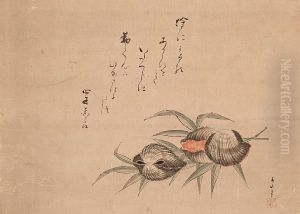Okada Gyokuzan Paintings
Okada Gyokuzan was a Japanese artist born in 1737 in the Edo period, a time characterized by economic growth, strict social order, isolated foreign policies, and a flourishing culture in the arts and literature. Gyokuzan was an ukiyo-e artist and is known for his woodblock prints and paintings. Ukiyo-e, which translates to 'pictures of the floating world', refers to a genre of Japanese art that thrived from the 17th through 19th centuries and frequently depicted scenes from history, theater, and the pleasure quarters of Japan.
Gyokuzan's work, like that of many ukiyo-e artists, showcased the beauty of the everyday life of Edo (modern-day Tokyo) and the entertainment districts. His prints often included beautiful courtesans, kabuki actors, and landscapes. Although not as well-known as his contemporaries such as Katsushika Hokusai or Utagawa Hiroshige, Gyokuzan contributed to the art form with his distinctive style and attention to detail.
Little is known about Gyokuzan's life outside of his artistic work. He was active during a time when the ukiyo-e style was evolving, incorporating more Western elements of shading and perspective, which had begun to infiltrate Japanese art due to the gradual end of the country's isolationist policies. Gyokuzan's prints and paintings remain valuable for their historical and cultural significance, capturing the spirit of an era that was on the cusp of modernity.
Okada Gyokuzan passed away in 1812. His works continue to be appreciated by art collectors and historians, and they serve as important cultural artifacts that offer insights into the Edo period's visual culture. Despite the lack of extensive personal records, Gyokuzan's artistic legacy is preserved in the ukiyo-e prints and paintings that survive him.
